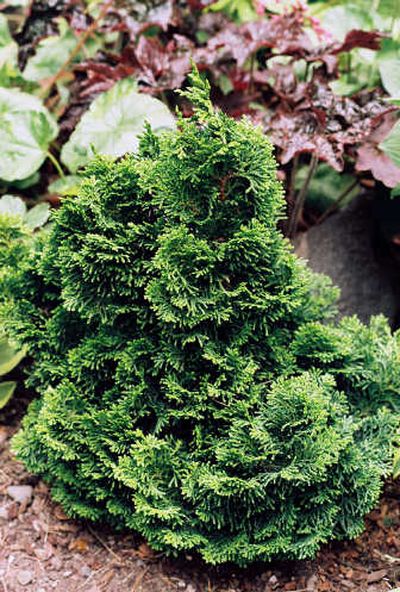Compact plant with big name

Chamaecyparis obtusa may sound like a mouthful, but this species of Japanese evergreens produces some of the daintiest and best kept forms in the modern landscape garden.
I started collecting them about six years ago after a landscape designer urged me to include these evergreens among my seasonal perennial plants. The idea was to give the landscape year-around structure.
In the years since, I have tried to convince people that Chamaecyparis belongs in their landscapes, and one friend has been searching across Spokane to find the diminutive ‘Nana,’ a rounded, compact evergreen that stands no more than a foot tall.
Also known as false cypress or Hinoki cypress, Chamaecyparis obtusa (pronounced cam-uh-sip-uh-ris ub-too-suh) is commonly seen in landscapes in western Oregon and Washington, but is only now gaining respect in Spokane, where landscapes have been dominated for too long by the ever-present juniper.
In the wild, Chamaecyparis are large trees, but the nursery trade over the years has manipulated the plants to produce smaller cultivars suitable for home landscaping. Japanese species are considered sacred in the Shinto faith, according to Oregon State University’s landscape plant guide.
In addition to obtusa, the genus also includes Chamaecyparis pisifera (Japanese false cypress), Chamaecyparis nootkatensis (Alaska cedar) and Chamaecyparis lawsoniana (Port Orford cedar). The Alaska cedar has several useful cultivars that are narrow and upright, including the commonly seen ‘Pendula’ with is curtains of green foliage. The pisifera cultivar, known as gold thread-branch cypress, has been used by landscapers here for years.
Alan Tower at Tower Perennial Gardens, 4010 E. Jamieson Road, calls chamaecyparis one of the most useful plants for gardeners and carries a number of cultivars. They are frequently carried at other nurseries around the region. Iseli Nursery, an Oregon wholesaler, produces nearly three dozen varieties of obtusa alone. To view some, check out their Web site at www.iselinursery.com and go to the link to conifers.
Hardy to about minus 20 degrees, obtusas are considered reliable for the Spokane and Coeur d’Alene region, but may be susceptible to partial die-back in severe arctic cold or if their roots dry out in the winter. They generally prefer sun, but are not fond of extreme heat. They may be grown in partial shade as well.
One of the most common dwarfs is ‘Kosteri,’ which might attain a height of three feet eventually. Mine have been growing for six years and are still less than two feet tall. Other landscape varieties could attain more substantial heights of 10 to 12 feet.
All four species have been used to develop different types of foliage, including those with fern spray leaves and soft, fluffy juvenile growth. Many of them are variegated with yellow or white. Foliage on some of the green obtusa cultivars gives off a captivating bluish cast. I have one called ‘Snowkist’ that I keep in a pot on the porch. I leave it out all year long except during severe cold when I put in a cool basement for protection. True to its name, the foliage is adorned with specks of white, reminiscent of snow.